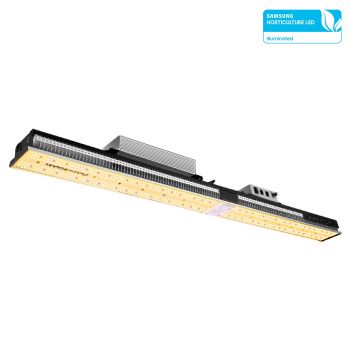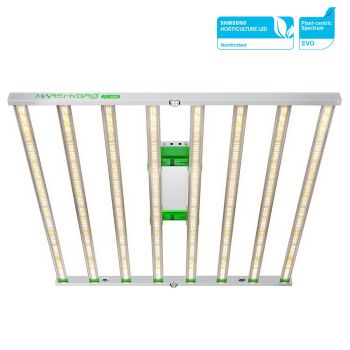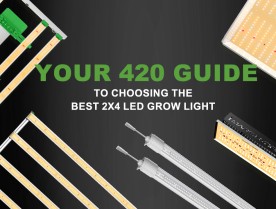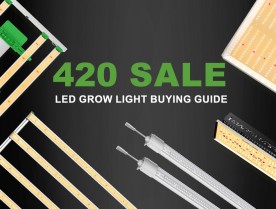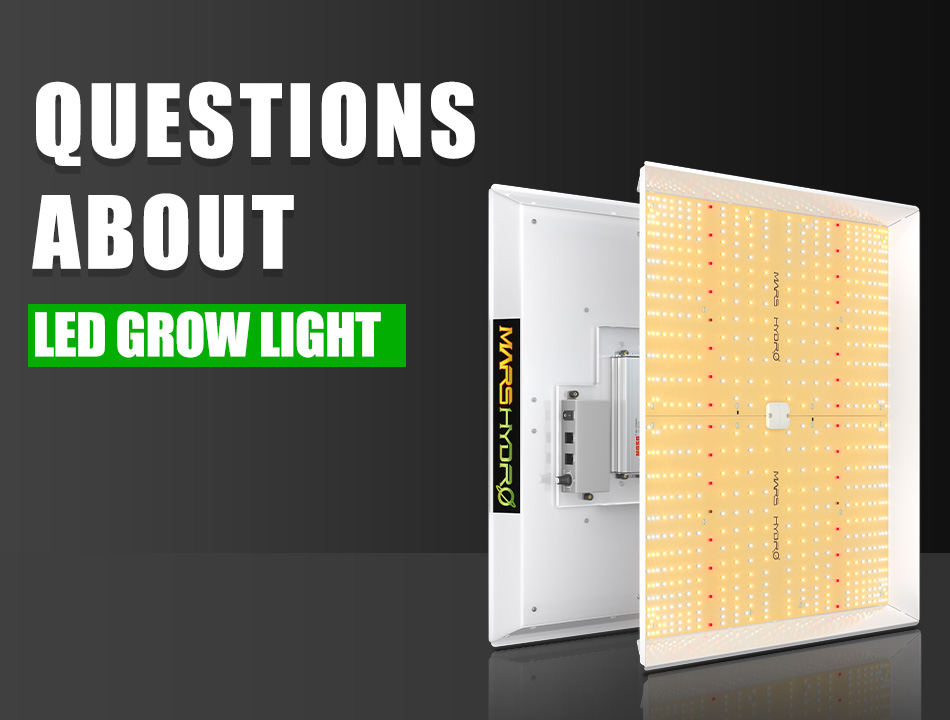
Growing plants indoors can be challenging, especially when it comes to providing them with the right amount and quality of light. This is where LED grow lights come in. LED grow lights are becoming increasingly popular among indoor gardeners due to their energy efficiency, cost-effectiveness, and ability to provide the right spectrum of light for optimal plant growth. However, with so many options available on the market, it can be overwhelming to choose the right LED grow light for your specific needs. In this guide, we will answer 20 common questions about growing with LED grow lights to help you make informed decisions and achieve successful indoor plant growth.
-
How do LED grow lights work, and what makes them different from other types of grow lights?
LED grow lights work by emitting electromagnetic radiation in the visible and non-visible spectra to promote photosynthesis in plants. Specifically, the spectrum of LED grow lights can be customized to whatever you need to meet your lighting settings and your plants' requirements. For example, the red and blue light in the PAR range, and the Ultraviolet (UV) and Infrared (IR).
LED grow lights differ from other types of grow lights, such as high-pressure sodium (HPS) or metal halide (MH) lights, in several ways. Firstly, LED grow lights are much more energy-efficient than HPS or MH lights, which means they consume less power while producing the same amount of light. Secondly, LED grow lights have a longer lifespan than HPS or MH lights and do not require as much maintenance. Thirdly, LED grow lights produce less heat than HPS or MH lights, which can be beneficial for plant growth and reduce the need for cooling systems.
-
Are LED grow lights energy-efficient and cost-effective compared to other types of grow lights?
Yes, LED grow lights are generally considered to be more energy-efficient and cost-effective compared to other types of grow lights, such as high-pressure sodium (HPS) or metal halide (MH) lights.
LED grow lights consume less power while producing the same amount of light as traditional grow lights, resulting in energy savings of up to 40-60%. This means that LED grow lights are much more efficient at converting electricity into usable light energy for plant growth, which can translate into significant cost savings over time.
In addition, LED grow lights have a longer lifespan than HPS or MH lights and require less maintenance, reducing replacement costs and maintenance expenses. LED grow lights also produce less heat than HPS or MH lights, which can lower the need for cooling systems and further reduce energy costs.
-
How far away should I place my LED grow lights from my plants?
The optimal distance between LED grow lights and plants depends on several factors, such as the type of plants, the wattage of the LED grow lights, and the growth stage of the plants.
As a general rule, LED grow lights should be placed at a distance of 12-24 inches (30-60 cm) above the plants during the seedling and vegetative stage and 8-16 inches (20-40 cm) during the flowering stage. However, this distance may vary depending on the specific LED grow light model and the plant's light requirements.
It is also important to ensure that the LED grow lights cover the entire growing area evenly to ensure that all plants receive sufficient light.

-
How many hours should I run LED grow lights for my plants?
The number of hours that LED grow lights should be run for plants varies depending on the stage of growth and the specific light requirements of each type of plant. As a general rule, most plants require between 12 and 18 hours of light per day during the vegetative stage and 12 hours of light per day during the flowering stage.
It is important to note that some plants may require more or less light than others, and it is always a good idea to research the specific light requirements of the plants being grown to determine the optimal light schedule. Additionally, some growers may choose to use a "24/0" light schedule, where the plants receive 24 hours of light per day during the vegetative stage, although this is not necessary for all plants and may increase energy costs.
-
How do I choose the right size and type of grow light for my growing space?
To choose the right size and type of LED grow light for your growing space, you should consider the following factors:
-
The size of your growing area: Determine the square footage of your growing area to determine the amount of light you need. A general rule of thumb is to provide 30-50 watts of actual wattage per square foot for flowering plants and 20-30 watts per square foot for vegetative plants. And if your growing area is somewhat small or enclosed, it's best to choose led lights over other types.
-
The type of plants you are growing: Different plants have different light requirements. As mentioned above, some plants require higher light intensity and longer lighting time, while other plants may be stressed or burned under that level of lighting. If you are growing for the first time, it is best to buy an LED grow light that consumes 100 to 300 watts and has a dimming function for possible situations.
-
The growth stage of your plants: Vegetative and flowering stages require different spectrums of light, so choose a LED grow light that has adjustable settings to accommodate both growth stages.
-
The light spectrum: Different light spectrums can affect plant growth and development. Look for grow lights that offer a full spectrum of light, including blue, red, and white light.
-
The cooling system of the LED chips: Look for LED grow lights with passive and effective cooling systems.
-
Brand reputation and customer reviews: Research different brands and read customer reviews to ensure you choose a reliable and effective LED grow light.
By the way, it's always better to have slightly more light than not enough, as insufficient light can stunt plant growth and reduce yields.
-
Can LED grow lights be used for all types of plants, or are they best suited for certain types of plants?
LED grow lights can be used for a wide variety of plants, including leafy greens (such as lettuce, spinach, and kale.), herbs (such as basil, thyme, and cilantro), fruiting vegetables (such as tomatoes, peppers, and cucumbers), root vegetables (such as carrots, potatoes, and radishes), flowers (such as orchids, roses, and tulips), and weed plants.
Using LED grow lights with a targeted spectrum, (for example, full-spectrum lighting along with UV lighting) or placing them at special angles for greater penetration, you can grow any plant you like, without any worries.
-
What are the potential risks and drawbacks of using LED grow lights?
While LED grow lights are generally considered safe and efficient, there are some potential risks and drawbacks to be aware of.
One of the main risks is that LED grow lights can provide a too-strong light intensity, which can potentially damage plants if they are placed too close.
Another potential drawback is that some LED grow lights may not emit a true full spectrum of light or emit an imbalanced spectrum, which can affect plant growth and yield.
It's important to note that there are many different types of LED grow lights on the market, and not all of them are created equal. Low-quality lights may not perform as well as advertised, or may not last as long as higher-quality models and even cause fire hazards. It's important to do your research and choose a reputable brand that offers high-quality lights with proven performance and reliability

-
How long do LED grow lights typically last?
LED grow lights typically last for several years, depending on the quality of the fixture and how often they are used. Some LED grow lights may last for up to 50,000 to 100,000 hours, while others may only last for 20,000 hours.
Therefore, it is recommended to replace LED grow lights every 5-7 years to ensure optimal plant growth and productivity.
-
How can I tell if my LED grow lights are working properly, and when do I need to replace them?
Here are a few ways to tell if your LED grow lights are working properly and when you might need to replace them:
-
Check for brightness: Over time, LED grow lights can start to lose brightness, which can impact plant growth. If you notice that your plants aren't growing as well as they used to, it may be a sign that your lights are losing their brightness.
-
Check for color: If your LED grow lights are designed to emit a certain spectrum of light, make sure that the color of the light is still accurate. If it starts to shift or change, it may be time to replace the lights.
-
Monitor heat: If your LED grow lights are getting too hot, it can cause damage to your plants and the lights themselves. Make sure to monitor the temperature around your grow lights to ensure they're not overheating.
-
Check for flickering: If your LED grow lights start to flicker or blink, it's a sign that there may be a problem with the lights themselves. In this case, it's best to replace the lights to avoid any further issues.
Any LED will light decay. Therefore, if you notice any of the above issues, it's a good idea to consider replacing your lights to ensure that your plants continue to receive the light they need for healthy growth.
-
What is the best way to clean and maintain my LED grow lights?
Here are some tips on how to clean and maintain your LED grow lights:
-
Turn off and unplug the lights before cleaning them.
-
Use a soft cloth or sponge to wipe off dust and debris from the surface of the lights.
-
For more stubborn dirt, you can wipe the lights by spraying a small amount of ethanol on the surface. Avoid using harsh chemicals or abrasive materials that can damage the surface of the lights.
-
Clean the fans and vents (if there are any) on the lights to ensure proper airflow and prevent overheating.
-
Check the wiring and connections regularly to make sure everything is secure and there are no loose or damaged parts. If there's dirt, use a solution of mild soap and warm water to wipe them.
-
Replace any damaged or broken parts immediately.
-
Clean the grow room regularly to prevent the buildup of dust and debris that can block the light and affect its performance.
Proper maintenance and cleaning of LED grow lights are crucial to ensure their optimal performance and longevity.
-
Can LED grow lights be used for hydroponic or aeroponic growing systems?
Yes, LED grow lights can be used for hydroponic and aeroponic growing systems. In fact, they are often the preferred choice for these types of systems.
Hydroponic and aeroponic systems are methods of growing plants without soil, typically using a nutrient-rich water solution to provide the necessary nutrients to the plants. LED grow lights are well-suited for these systems because they can be positioned close to the plants without causing excessive heat, they can provide the right spectrum of light to support plant growth, as well as they are more energy-efficient than other types of light.
-
Can I use LED grow lights for both vegetative and flowering stages of plant growth?
Yes, LED grow lights can be used for both vegetative and flowering stages of plant growth. The same LED grow light can be used for both stages, but you may need to adjust the light's intensity (and spectrum) to meet the specific needs of each stage.

-
Are there any additional accessories or equipment that I need to use in conjunction with my LED grow lights?
Depending on your setup and specific needs, there may be additional accessories or equipment that can enhance the performance of your LED grow lights. Here are some examples:
-
Reflectors: Reflectors help to increase the efficiency of your LED grow lights by reflecting light back onto your plants.
-
Timers: Timers are used to control the amount of time your LED grow lights are on and off, which is important for regulating the growth and development of your plants. Additionally, you may opt to obtain a smart hub controller for your LED lights. It's worth noting that some LED grow lights come equipped with a timer function, making them smart devices in and of themselves.
-
Grow tents or grow rooms: Grow tents or grow rooms provide a controlled environment for your plants, which can help to maximize growth and yield.
-
Ventilation systems: Ventilation systems are important for regulating temperature and humidity levels in your grow space, which can affect the health and growth of your plants.
-
CO2 supplementation: CO2 supplementation can help to boost plant growth and yield, especially when used in conjunction with high-intensity LED grow lights.
-
pH and nutrient monitoring equipment: pH and nutrient monitoring equipment is essential for ensuring that your plants are getting the right amount of nutrients, which can affect their growth and development.
-
Hydroponic or aeroponic systems: Hydroponic or aeroponic systems are often used in conjunction with LED grow lights to provide plants with a nutrient-rich solution and an optimal growing environment.
The specific accessories and equipment you need will depend on the type of plants you are growing, your growing space, and your overall goals for your plants. It's important to do your research and consult with experts to determine the best setup for your needs.
-
How can I prevent light burn on my plants when using LED grow lights?
Light burn is a common problem that can occur when plants are exposed to excessive light from LED grow lights. To prevent light burn on your plants, it is important to keep the grow lights at the appropriate distance from the plants and to monitor the intensity of the light.
One way to prevent light burn is to follow the recommended distance guidelines provided by the manufacturer of your LED lights. Generally, LED grow lights should be kept at least 16 to 24 inches away from the tops of plants during the vegetative stage and 12 to 18 inches away during the flowering stage.
You can also reduce the risk of light burn by gradually increasing the light intensity over time, rather than exposing plants to high-intensity light right away.
Additionally, it's important to monitor the temperature and humidity in your grow space, as high temperatures or low humidity can exacerbate light burn.
If you notice signs of light burns, such as brown spots or wilting leaves, move the lights further away from the plants and reduce the light intensity.
-
Can LED grow lights be used for outdoor growing or greenhouse applications?
Yes, LED grow lights can be used for outdoor growing or greenhouse applications. In fact, they are often used in greenhouses to supplement natural sunlight or to provide light during the winter months when daylight hours are shorter.
When using LED grow lights for outdoor growing or greenhouse applications, it is important to choose the appropriate wattage and spectrum for the plants being grown, as well as to position the lights at the appropriate distance from the plants to avoid light burn. Also, ensure that the LED grow lights are rated for outdoor use and are weather-resistant.
-
Are there any certifications or standards that I should look for when selecting an LED grow light?
Yes, there are certifications and standards to look for when selecting an LED grow light to ensure its safety, reliability, and energy efficiency. The most common certifications and standards include:
-
UL certification: This certification ensures that the LED grow light meets safety standards set by Underwriters Laboratories, an independent safety science company. Look for the UL mark on the product or packaging.
-
DLC certification: DesignLights Consortium, which is a non-profit organization that promotes energy-efficient lighting solutions. They have developed a certification program specifically for horticultural lighting products, including LED grow lights. The DLC certification ensures that the product meets certain performance and quality standards, and it is often a requirement for qualifying for energy rebates or incentives.
-
Energy Star certification: This certification is also specific to energy efficiency and indicates that the LED grow light meets certain energy efficiency guidelines set by the Environmental Protection Agency. Look for the Energy Star label on the product or packaging.
-
RoHS compliance: This compliance ensures that the LED grow light meets certain standards for the restriction of hazardous substances in electronics. Look for the RoHS symbol on the product or packaging.
-
FCC compliance: This compliance ensures that the LED grow light meets certain standards for electromagnetic interference and radiofrequency interference. Look for the FCC mark on the product or packaging.
-
CE marking: This marking indicates that the LED grow light meets certain safety, health, and environmental protection standards for products sold within the European Economic Area. Look for the CE mark on the product or packaging.
Be sure to check for these certifications and standards to ensure that the product meets the necessary safety and energy efficiency requirements.

-
How can I calculate the optimal number of LED grow lights to use for my growing space?
One way to calculate the optimal number of LED lights is to use the recommended wattage per square foot for your plants and growing space. For example, most plants require between 30 to 50 watts of light per square foot during the vegetative stage and 50 to 70 watts per square foot during the flowering stage.
To calculate the number of LED grow lights you need, divide the total wattage required by the wattage of each LED grow light. For example, if you are growing in a 4' x 4' tent and require 240 watts of light during the flowering stage, and your LED grow lights are 120 watts each, then you would need two LED grow lights to meet your lighting needs.
It's important to note that other factors, such as the angle of the LED grow light lenses and the height at which they are mounted, can also affect the coverage area and intensity of the light. So, it's better to consult the manufacturer's guidelines or consult with a professional to ensure you have the right number and type of LED grow lights for your specific growing setup.
-
How do I properly dispose of my LED grow lights when they reach the end of their lifespan?
When your LED grow lights reach the end of their lifespan, it's important to dispose of them properly to minimize their impact on the environment. Here are some tips on how to dispose of your LED grow lights responsibly:
-
Check with your local recycling center: Some recycling centers may accept LED grow lights for recycling, so it's worth checking with them to see if this is an option in your area.
-
Look for electronics recycling programs: Many electronics retailers and manufacturers have recycling programs in place for electronic devices, including LED grow lights. Check with your local electronics stores to see if they offer this service.
-
Contact the manufacturer: Some LED grow light manufacturers offer disposal and recycling services for their products, so it's worth reaching out to the manufacturer to see if they have any options available.
-
Follow local regulations: Be sure to follow any local regulations regarding the disposal of electronic devices, including LED grow lights. This may involve specific guidelines or procedures that must be followed to ensure proper disposal.
-
Do not dispose of in regular trash: Do not simply throw your LED grow lights in the regular trash, as they can contain hazardous materials that can harm the environment if not disposed of properly.
It is not recommended to throw LED grow lights in the regular trash as they may end up in a landfill and potentially harm the environment.
-
Can LED grow lights be used for multi-tiered growing setups?
Yes, LED grow lights can be used for multi-tiered growing setups. In fact, many growers use LED grow lights for vertical farming and multi-tiered setups because of their energy efficiency and cool running ability.
It is important to consider the spacing and height of the different tiers to ensure that each level is receiving sufficient light for plant growth. Growers may need to adjust the hanging height of the LED grow lights or use adjustable light hangers for their system. Or buy led grow lights that provide adjustable lighting levels for plants at different growth stages.
-
What are some emerging trends or innovations in LED grow light technology?
There are several emerging trends and innovations in LED grow light technology that aims to improve efficiency, performance, and cost-effectiveness. Some of these developments include:
-
Smart controls and automation: Many LED grow lights now come with built-in sensors, timers, and controllers that allow growers to adjust the lighting spectrum, intensity, and duration automatically. Some models can even integrate with smartphone apps, allowing growers to monitor and control their lights remotely.
-
Improved efficiency and output: Manufacturers are constantly improving the efficiency of LED grow lights, resulting in higher yields and lower energy costs. Some manufacturers are making higher-output LED grow lights for those seeking higher light intensities.
-
Customizable spectra: LED grow lights can now offer customizable spectra that allow growers to adjust the light spectrum to meet the specific needs of different plants at different stages of growth. Some models offer full-spectrum light that can replace natural sunlight.
-
Vertical farming systems: LED grow lights are being used to power vertical farming systems, which allow growers to stack multiple growing layers in a small space. This is particularly useful for urban farming or indoor growing where space is limited.
To stay up-to-date with the latest developments in LED grow light technology, it is recommended to follow industry news and publications, attend trade shows and conferences, and consult with reputable suppliers and manufacturers



